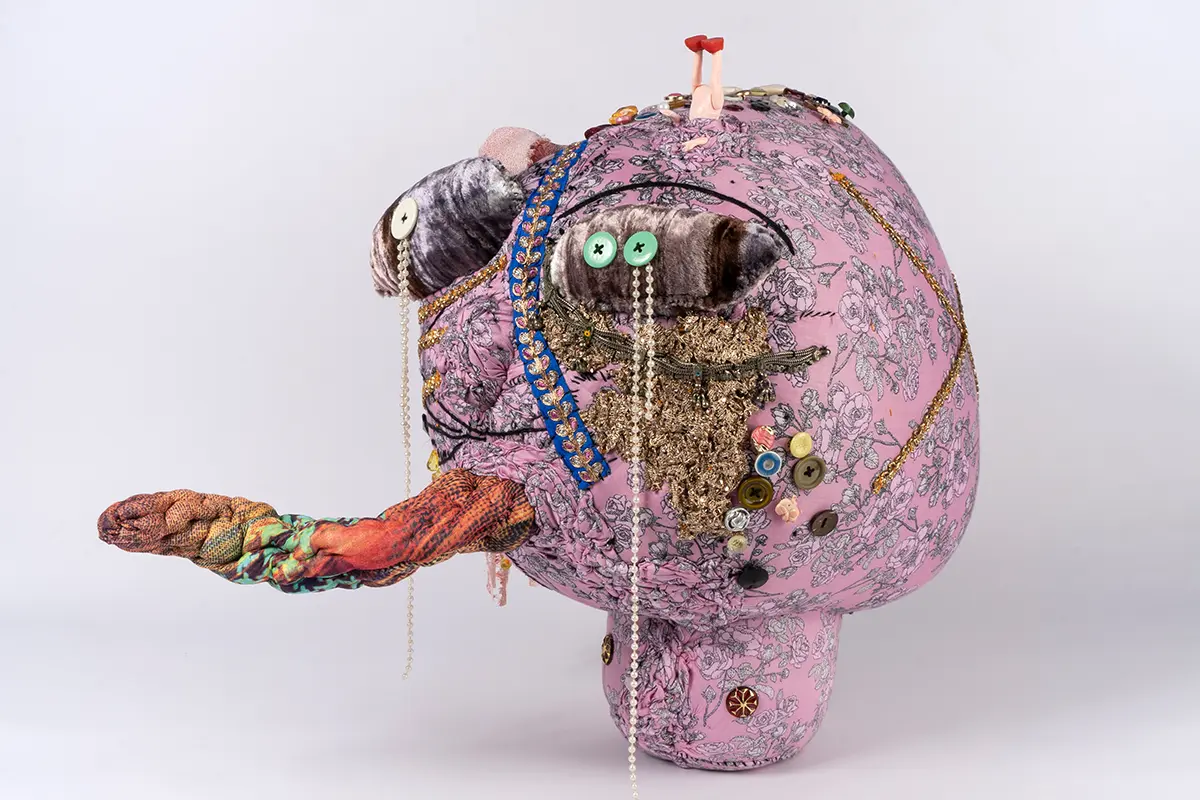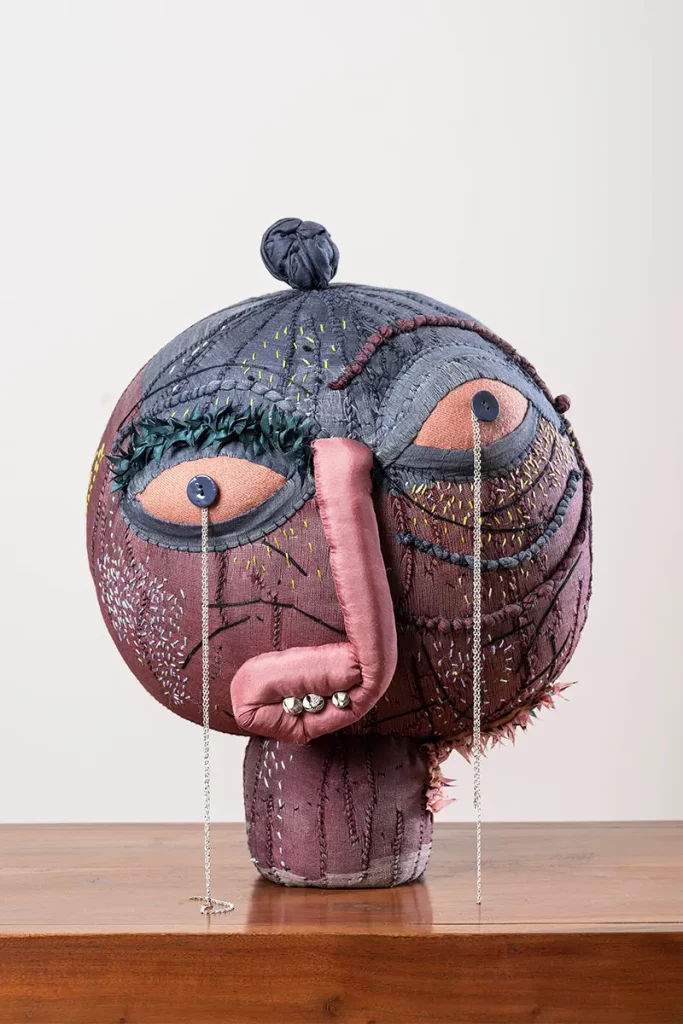Rural Indian subjectivity found in 3d textile sculptures. Gurjeet Singh handcrafts bold narratives of identity, isolation and sexual exploration into faces made of fabric and stuffing
Gurjeet Singh: a dissonance in social fabric, sculptures about hak or rights
Battling a society undernourished in cultural liberalism, Gurjeet Singh’s artistic endeavors are a journey of self-exploration. His handcrafted textile sculptures form peculiar faces, patchworked and embroidered into existence from fabric scraps and discarded applique. Every bit of needlework on these intentionally misshapen sculptures has a meaning: threads criss-crossing over small mirrors represent obscured views of self, a string of beads represents falling tears.
Pursuing themes of identity, isolation and sexual orientation, the artist’s work is a result of his exposure to a rural society with dated notions and brimming with judgment. Responding to a dissonance in social fabric, Singh’s work is emphatic. He is on a personal quest to refute «the question everyone always asks and fears: what will people say about this?»
Still, the artist is quick to distinguish his art as a form of rebellion. Instead Singh says his soft sculptures are simply about «hak» or rights: «My art isn’t exactly a rebellion, it is just a way to spread the message that everyone has the right to live the way they please».
Sculptures by Gurjeet Singh and the ugly truth, personified and then embellished
Singh’s art is a characteristic series of soft, stuffed, busts with misshapen faces. Pieced together with discarded fabric scraps in bright bold colors. Embellished with pre-used sequin, buttons, beads, mirror-work and forgotten bits and bobs. These sculptures are peculiar in their features with «bejeweled butthole mouths, kaleidoscopic eyes, a riot of phallic objects spilling out of every possible crevice».
With a bold and exuberant facade, Singh’s chorus of misfits is similarly stuffed on the inside – with colorful tales of emotion from socially-oppressed, marginalized voices. He explores art as a response to sexual typecasting and gender roles in conservative society of rural India. In his first solo exhibition, ‘This Is What it’s Like To Be Fabulous?’ These sculptures were given a first person narrative: «We are every grotesque desire, every illicit thought, every insatiable impulse, protrud(ed) out into the world».
Who are the chorus of misfits? – Gurjeet Singh’s work
Singh shares the true stories and interpretations behind some of his most crowd-pleasing handmade faces: «Portrait of a friend-Lakhi is about a gay friend of mine whose dreams of becoming a make-up artist and hairdresser were squashed by his family. They opposed it thinking it wasn’t a profession for ‘normal’ or masculine men. The sculpture shows Lakhi’s broken dreams but also reflects a bigger theme about how social gender constructs dictate everything from behavior and lifestyle to careers».
The artwork is made of cloth deemed industrially defective and embellished with imperfect, broken beads and buttons. The face has bulging eyes and a golden teardrop to emphasize the stereotype of boys don’t cry. There are phallic protrusions and illusions to emphasize the necessity for masculinity.
The artwork, Lambi Zubaan by Gurjeet Singh
The artwork, Lambi Zubaan (translation: ‘having a long tongue / big mouth,’ meaning: to spread gossip), is a direct nod to society’s inherent business of whispering gossip and creating scandals. A naked doll inserted into the bust’s scalp refers to lack of emotions, beyond physicality in relationships and the string of white pearl-like beads are precious tears being shed.
In another sculpture, there’s a finger covering the mouth. It is a layered action: from one viewpoint it represents people exerting control over inferiors, telling them what to do and say, whereas on the other it’s an action on the part of the marginalized and discriminated, silencing those who question their identity.
«I think everyone has the right to speak their mind, but people try to stifle you – saying don’t do this, don’t say that. This is how my narrative of addressing stereotypical thoughts through art started».
Sculptural antidotes to a harsh reality in Gurjeet Singh’s approach
Materials and fabrics have their own story too, according to Singh, especially used, discarded and defective cloth. «When I work with defective material, I feel like I’m freeing something locked inside me, I find peace, but that same emotion doesn’t reflect in works with new fabric».
The artist explains that he finds comfort in using what others consider useless. Being a victim of discrimination, bullying and harassment since childhood, Singh grew up believing the taunts that were thrown at him. «When people say things and they enter your mind and impact your psyche. In school I was bullied for being like a girl, for having soft hands. I was harassed, touched and kissed by young males behind locked classroom doors. Back then I believed it was my defect and I thought about suicide too».
Singh, who only discovered and embraced his identity and sexuality through the process of art, finds its healing power liberating. His sculptures are antidotes to a harsh world’s perceived reality. «When I use leftover materials in my art and give them a new life, it feels like I’m healing some of my own trauma».
Gurjeet Singh – discovering sexuality through art
Singh shares that art enabled him to express his sexuality even before he could admit it to himself. It was the actions of cutting, sewing, sketching that weakened his inner fears and negativity. Discovering and exploring sexuality has since been organically integrated into his brand of art. While Singh’s work is largely about society norms, gender roles and typecasting, LGBTQ+ is a prominent theme.
He explains his artistic goals: «Stories that may be a part of mainstream narratives are still hidden in parts of the country like where I am from. My work is about finding oneself and revealing hidden stories». No sculpture till date has been pre-planned. The artist sketches his idea and then improvises as he goes along, based on the conversations he’s had, the story of the material etc.
Singh’s work is as much about emotions as it is about handicraft: «The sculptures are not direct representations of the people and their stories, but more about my interpretations. I always look under the masks, find the relationships and think about the color, textures and shapes of their individual lives».
Gurjeet Singh’s building blocks: finding a place in the art world
Hailing from a small village, Algon Kothi in Punjab, near the Pakistan border, Singh and his family weren’t aware about a professional degree or the potential for a career in art until 2010. Upon first receiving an acceptance into a government college in Chandigarh for sculpture, Singh rejected the idea and pursued a different path. Since then he has come full circle as a young and celebrated textile sculpture artist in India and the UK.
Supporting marginalized voices: Gurjeet Singh
The youngest a brother and four sisters, Singh was influenced by his family, where the women were engaged in sewing clothes, motifs on home furnishing and mending. He reveals that as a child, he often practiced on the family sewing machine when no one was using it.
His interest in art further developed during college when he visited artisans, learning traditional techniques of Bengali wash dye and miniature art. Singh’s first sculpture dates back to 2018, titled Pink Lady, and since then he has had numerous solo exhibitions.
Singh has dabbled into performance art – depicting a contradictory theme of a gay wedding in rural India. His ambitions support marginalized voices, as he hopes to animate his soft sculptures to better narrate their stories through film.
Gurjeet Singh
Chandigarh-based emerging Indian artist, Gurjeet Singh handcrafts soft sculptures from textile scraps and applique. His artwork is representative of gender typecasting in parts of rural India. With bold and loud sculptures, he hopes to give voice to the stories of those mistreated and controlled by social norms. Singh has had numerous solo exhibitions in India and dabbled in performance art as well. He is represented by Chemould Gallery.




















